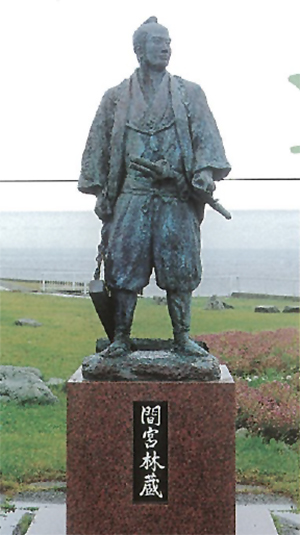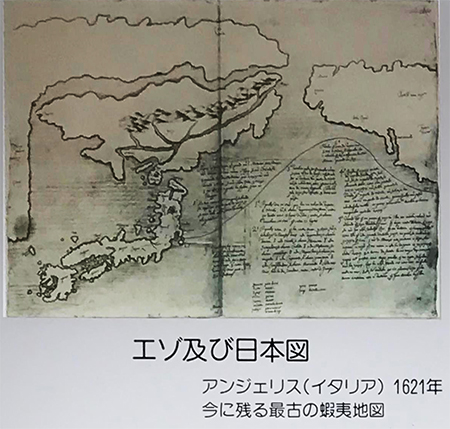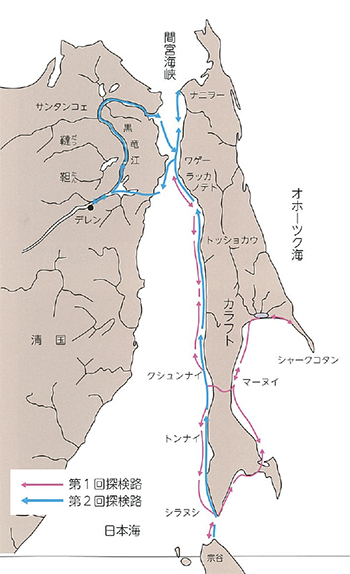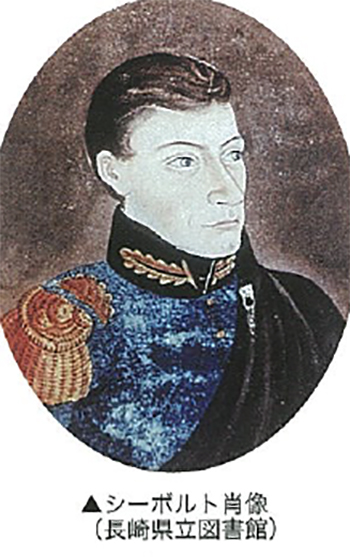


北海道神宮境内には「開拓神社」が置かれている。わたしの好きな毎朝の散歩道の定番コースでして強い親近感を持って参拝させていただいている。記憶が定かではないけれど小学校の「社会科」では定番の地域史にそれらの名前は刻印されている。北海道開拓に功績のあった人物を顕彰する宮。地域としての北海道は公式的には幕末の時期に歴史が刻印されはじめるのですね。
そのなかに伊能忠敬、近藤重蔵、高田屋嘉兵衛、松浦武四郎、松田伝十郎、間宮林蔵、最上徳内と言った北海道の地勢情報の開拓者たちの名前が記されている。高田屋嘉兵衛は北前船交易の主人公として司馬遼太郎「菜の花の沖」に描かれた。わたしの家系伝承探索をしていると、このあたりにルーツを感じさせられる部分が強い。興味を持って調べていたら、播磨灘物語の巻末の文章でわが家の伝承と司馬さんのご先祖さまとがクロスする箇所もあった。
そういう時代の感覚が、間宮林蔵さんの足跡を追体験するとふつふつと沸き起こって来る。間宮林蔵が江戸で最期を迎えたとき、幕臣として北方探索を重ねていたかれの事跡が残された資料類は幕府が「国家機密」書類として回収したとされている。鎖国が国是の時代にあって幕府として北方の領土について情報を把握することがいかに機微なことがらであったのかが偲ばれる。
そして明治維新政府がこうした作業に関わった多くの幕臣たちをむしろ顕彰するに至ったことからは、北海道をはじめとする北方の領土問題がいかに明治という時代にとって枢要だったかをあらわしている。明治の政府の中枢であった黒田清隆はむしろ積極的に維新戦争での敵方・幕臣たちにリスペクトしている痕跡がある。北海道を中心とする領土問題は近代国家基幹部分が形成された中心軸だった。北海道人にとってこの時代感覚は毎日の神社参拝を通してなお、なまなましく生き続けている。
今回つくばみらい市で間宮林蔵生家を訪問したことで、北海道はこうしたフロンティアたちのさまざまな活動によって基礎が形成されたことを追体験させられている。
上の写真の銅像は稚内・宗谷岬に残された間宮林蔵像。幕臣として、国命である領土調査活動としてかれは樺太島に渡り、大陸と樺太を隔つ「間宮海峡」を確定させるに至る。その後の対ロシア外交交渉で世界の「公知」事実として根拠を示し得た発見だった。

こうした事実は当時のオランダ人医師シーボルトによって世界に情報拡散されていった。間宮海峡という名前もこの経緯によって世界標準になっていった。世界史と日本史が戦国期以来ふたたび交叉し始める。戦国期が大名たちが主語で語られるのに対して、幕末明治はもっと庶民の側に近い個人名が主語になっていく。こうして間宮林蔵の息づかいまで普通に知れることは、すばらしい。
English version⬇
The Formation of a Modern Nation, Hokkaido, and Territorial Issues – Rinzo Mamiya’s Birthplace – 6
At the end of the Edo period and during the Meiji era, there were countless activities that martyred the “national interest” regardless of whether it was Satcho or the shogunate. In Hokkaido, such spirits are enshrined in the Kaitakushi Shrine.
The Kaitakushi Shrine is located within the precincts of the Hokkaido Shrine. It is a regular course of my favorite morning walk, and I visit the shrine with a strong sense of familiarity. I am not sure if my memory of the shrine is correct, but its name is imprinted in the standard local history book for elementary school social studies classes. The shrine honors those who have contributed to the development of Hokkaido. So Hokkaido as a region officially begins to have its history imprinted at the end of the Edo period.
Among them are the names of pioneers of Hokkaido’s geographical information, such as Ino Tadataka, Kondo Shigezo, Takataya Kahei, Matsuura Takeshiro, Matsuda Denjuro, Mamiya Rinzo, and Mogami Tokunouchi. Takataya Kahei was depicted in Ryotaro Shiba’s “Nanohana no Oki” as a hero of the Kitamae-bune trade. In my search for family lore, I have a strong sense of my roots in this area. As I was researching with interest, I found a passage at the end of Harimanada Monogatari (Tales of Harimanada) that crossed my family traditions with those of Mr. Shiba’s ancestors.
Such a sense of the times arises when I relive Rinzo Mamiya’s footsteps. When Rinzo Mamiya met his end in Edo, it is said that the shogunate had recovered the documents that contained the traces of his many northern expeditions as a vassal of the shogunate as “state secrets”. In an era when the national policy was to keep the country closed to the outside world, it is easy to understand how sensitive it was for the Shogunate to obtain information on the northern territories.
The fact that the Meiji Restoration government honored the many shogunate officials who were involved in this process shows how important the issue of northern territories, including Hokkaido, was to the Meiji era. There are traces that Kiyotaka Kuroda, who was at the center of the Meiji government, actively respected his adversaries and shogunate vassals in the Restoration War. The territorial issue centering on Hokkaido was the central axis around which the core of the modern nation was formed. For the people of Hokkaido, this sense of the times is still vividly alive through their daily visits to the shrine.
Visiting the birthplace of Rinzo Mamiya in Tsukubamirai City, I was reminded that the foundation of Hokkaido was formed by the various activities of these frontiersmen.
The bronze statue in the photo above is the statue of Rinzo Mamiya left at Cape Soya in Wakkanai. As a shogunate minister, he traveled to Sakhalin Island as part of his territorial survey activities as ordered by the Japanese government and established the “Mamiya Strait” that separated Sakhalin from the mainland. The discovery was later used as a basis for diplomatic negotiations with Russia as a fact of “public knowledge” in the world.
This fact was spread around the world by Siebold, the Dutch physician of the time. The name “Mamiya Kaikyo” also became a global standard through this process. World history and Japanese history began to intersect again after the Sengoku period. While the subject of the Warring States period was the feudal lords, the subject of the late Edo and Meiji periods was individual names that were closer to the common people. It is wonderful to be able to know even the breath of Rinzo Mamiya in this way.
Posted on 5月 21st, 2023 by 三木 奎吾
Filed under: 歴史探訪







コメントを投稿
「※誹謗中傷や、悪意のある書き込み、営利目的などのコメントを防ぐために、投稿された全てのコメントは一時的に保留されますのでご了承ください。」
You must be logged in to post a comment.